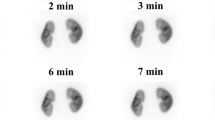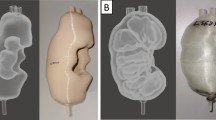Abstract
Renal imaging with different radiopharmaceuticals plays an essential role in diagnosing kidney diseases. Patients undergoing PET or SPECT renal scans receive a radiation dose that must be evaluated. It is imperative to acknowledge that pediatrics exhibit heightened sensitivity to radiation in contrast to adults. This research calculated absorbed doses in various organs and the effective dose per unit activity administered to pediatric patients aged one and five years undergoing renal SPECT scans using 99mTc-(DTPA, DMSA, MAG3, and EC). To achieve this objective, reference voxel phantoms representative of one- and five-year-old pediatrics, as stipulated in the International Commission on Radiological Protection (ICRP) Publication 143, were scrutinized employing the GATE simulation framework. The findings of this study were compared with the corresponding data stipulated in ICRP128, which pertains to stylized phantoms. The outcomes underscore that one-year-old subjects exhibit a higher effective dose in comparison with their five-year-old counterparts. Moreover, the radiopharmaceutical 99mTc-DMSA yielded the most substantial effective dose, while 99mTc-DTPA and 99mTc-EC (Normal renal function) registered the lowest effective dose for both one- and five-year-old patients. It is notable that, except 99mTc- (DTPA-Abnormal and DMSA), the absorbed dose by the bladder wall exerts the most pronounced influence on the effective dose values across all cases. By comparing the absorbed dose of the organs obtained in this research with the reported data of ICRP128, fundamental differences were revealed in some organs. Additionally, effective doses per unit activity administered calculated in this research emerge as comparatively lower than the corresponding data reported in ICRP128.










Similar content being viewed by others
Data Availability Statement
This manuscript has associated data in a data repository. [Authors’ comment: The data that support the findings of this study are either included in this paper or available from the references. Further data about the experiments and simulations described in this work are available from the authors upon reasonable request.]
References
M.T. Madsen, Recent advances in SPECT imaging. J. Nucl. Med. 48, 661–673 (2007). https://doi.org/10.2967/jnumed.106.032680
N. Zeraatkar, S. Sajedi, M.H. Farahani et al., Resolution-recovery-embedded image reconstruction for a high-resolution animal SPECT system. Phys. Med. 30, 774–781 (2014). https://doi.org/10.1016/j.ejmp.2014.05.013
S. Banerjee, M.R. Pillai, N. Ramamoorthy, Evolution of Tc-99m in diagnostic radiopharmaceuticals. Semin. Nucl. Med. 31, 260–277 (2001). https://doi.org/10.1053/snuc.2001.26205
F. Moradi, M.U. Khandaker, T. Alrefae et al., Monte Carlo simulations and analysis of transmitted gamma ray spectra through various tissue phantoms. Appl. Radiat. Isot. 146, 120–126 (2019). https://doi.org/10.1016/j.apradiso.2019.01.031
I. Mendichovszky, B.T. Solar, N. Smeulders et al., Nuclear medicine in pediatric nephro-urology: an overview. Semin. Nucl. Med. 47, 204–228 (2017). https://doi.org/10.1053/j.semnuclmed.2016.12.002
D. Bedriye Busra, B. Tansel Ansal, T. Bekir, K. Zehra Pinar, Comparison of DTPA and MAG3 renal scintigraphies in terms of differential renal function based on DMSA renal scintigraphy. Pak J. Med. Sci. 28, 795–799 (2012)
F.C. Domingues, G.Y. Fujikawa, H. Decker et al., Comparison of relative renal function measured with either 99mTc-DTPA or 99mTc-EC dynamic scintigraphies with that measured with 99mTc-DMSA static scintigraphy. Int. Braz. J. Urol. 32, 405–409 (2006). https://doi.org/10.1590/S1677-55382006000400004
F. Khanzadeh, N. Abdi-Goushbolagh, A. Banaei, A. Gh, Estimating the absorbed dose of organs in pediatric imaging of 99mTc-DTPATc-DTPA radiopharmaceutical using MIRDOSE software. J. Biomed. Phys. Eng. 9, 285 (2019)
A. Akhavanallaf, I. Shiri, H. Arabi, H. Zaidi, Whole-body voxel-based internal dosimetry using deep learning. Eur. J. Nucl. Med. Mol. Imaging 48, 670–682 (2021). https://doi.org/10.1007/s00259-020-05013-4
R. Protection. ICRP publication 103. Ann ICRP. 37(2.4), 2 (2007).
Y Li, S O'Reilly, D Plyku et al. Development of a defect model for renal pediatric SPECT imaging research. In: 2015 IEEE Nuclear Science Symposium and Medical Imaging Conference (NSS/MIC). 1–3 (2015). https://doi.org/10.1109/NSSMIC.2015.7582174
C. Lee, J.L. Williams, C. Lee, W.E. Bolch, The UF series of tomographic computational phantoms of pediatric patients. Med. Phys. 32, 3537–3548 (2005). https://doi.org/10.1118/1.2107067
H. Arabi, H. Zaidi, Applications of artificial intelligence and deep learning in molecular imaging and radiotherapy. Eur. J. Hybrid Imaging. 4, 1–23 (2020). https://doi.org/10.1186/s41824-020-00086-8
V Lohrabian, A Kamali-Asl, H Arabi et al. (2021) Dosimetric characterization of a new 192Ir pulse dose rate brachytherapy source with the Monte Carlo simulation and thermoluminescent dosimeter. arXiv preprint arXiv:2102.05953. (2021). https://doi.org/10.48550/arXiv.2102.05953
M. Zankl, Adult male and female reference computational phantoms (ICRP Publication 110). Japanese J. Health Phys. 45, 357–369 (2010). https://doi.org/10.5453/jhps.45.357
H. Zaidi, X.G. Xu, Computational anthropomorphic models of the human anatomy: the path to realistic Monte Carlo modeling in radiological sciences. Annu. Rev. Biomed. Eng. 9, 471–500 (2007). https://doi.org/10.1146/annurev.bioeng.9.060906.151934
W.E. Bolch, K. Eckerman, A. Endo et al., ICRP Publication 143: paediatric reference computational phantoms. Ann. ICRP 49, 5–297 (2020). https://doi.org/10.1177/0146645320915031
S. Mattsson, L. Johansson, S. Leide Svegborn et al., ICRP publication 128: radiation dose to patients from radiopharmaceuticals: a compendium of current information related to frequently used substances. Ann. ICRP 44, 7–321 (2015)
MIRD Pamphlet No. 1, Revised: A Revised Schema for Calculating the Absorbed Dose from Biologically Distributed Radionuclides (1975).
D. Sarrut, M. Bała, M. Bardiès et al., Advanced Monte Carlo simulations of emission tomography imaging systems with GATE. Phys. Med. Biol. 66, 10TR03 (2021)
GATE users guideV8.0. 2022. http://www.opengatecollaboration.org .
L. Hadid, A. Gardumi, A. Desbrée, Evaluation of absorbed and effective doses to patients from radiopharmaceuticals using the ICRP 110 reference computational phantoms and ICRP 103 formulation. Radiat. Prot. Dosim. 15, 141–159 (2013). https://doi.org/10.1093/rpd/nct049
A. Sadremomtaz, M. Mohammadi Ghalebin, Dose evaluation of the one-year-old child in PET imaging by 18F-(DOPA, FDG, FLT, FET) and 68Ga-EDTA using reference voxel phantoms. J. Biomed. Phys. Eng. 9, 025016 (2023). https://doi.org/10.1088/2057-1976/acba9e
T. Xie, N. Kuster, H. Zaidi, Effects of body habitus on internal radiation dose calculations using the 5-year-old anthropomorphic male models. Phys. Med. Biol. 62, 6185 (2017). https://doi.org/10.1088/1361-6560/aa75b4
M.V. Arteaga, V.M. Caballero, K.M. Rengifo, Dosimetry of 99mTc (DTPA, DMSA and MAG3) used in renal function studies of newborns and children. Appl. Radiat. Isot. 138, 25–28 (2018). https://doi.org/10.1016/j.apradiso.2017.07.054
Funding
No funding was received to assist with the preparation of this manuscript.
Author information
Authors and Affiliations
Corresponding author
Ethics declarations
Conflict of interest
The authors declare that they have no known competing financial interests or personal relationships that could have appeared to influence the work reported in this paper.
Rights and permissions
Springer Nature or its licensor (e.g. a society or other partner) holds exclusive rights to this article under a publishing agreement with the author(s) or other rightsholder(s); author self-archiving of the accepted manuscript version of this article is solely governed by the terms of such publishing agreement and applicable law.
About this article
Cite this article
Sadremomtaz, A., Mohammadi Ghalebin, M. Dose assessment of one- and five-year-old patients in renal SPECT scans with 99mTc-(DTPA, DMSA, MAG3, and EC). Eur. Phys. J. Plus 139, 61 (2024). https://doi.org/10.1140/epjp/s13360-023-04835-z
Received:
Accepted:
Published:
DOI: https://doi.org/10.1140/epjp/s13360-023-04835-z




